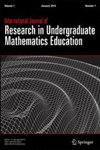如何根据听力困难的学生多边形?符号学方法的研究
IF 1.8
Q2 EDUCATION & EDUCATIONAL RESEARCH
International Journal of Research in Undergraduate Mathematics Education
Pub Date : 2022-06-24
DOI:10.17583/redimat.6097
引用次数: 2
摘要
本研究探讨重听学生在解释几何概念时,如何判断形状是否为多边形,以及使用哪些符号学来源。它定义了学生如何使用符号学资源与几何图形互动,并检查了这种与几何图形的多模态互动如何显示他们的推理。该研究是一个案例研究,并进行了三个重听学生。通过访谈收集数据,并进行内容分析。发现学生在识别多边形的过程中,注意形状的边、角、顶点。我们可以看到,学生们使用手势、言语、手语、碑文等符号来源以及个人或数学定义来表达多边形概念。然而,已经确定学生在解释概念的过程中存在一些误解。建议教师在概念定义中仔细选择词汇,正确教授概念,教师在课堂上使用手势表达概念。本文章由计算机程序翻译,如有差异,请以英文原文为准。
How Must a Polygon Be According to Hard of Hearing Students? An Investigation with a Semiotic Approach
This study explores how hard of hearing students decided whether the shape was a polygon and which semiotic sources were used when the students engaged in explaining geometrical concepts. It was defined how the students interacted with geometric shapes using semiotic sources and examined how such multimodal interactions with geometric figures displayed their reasoning. The study was a case study and carried out three hard of hearing students. The data was collected through interviews and analyzed with content analysis. It was detected that the students paid attention to edge, angle, and vertex of the shapes in the process of identifying polygon. It was seen that the students used gesture, speech, sign language, inscriptions which are semiotic sources and personal or mathematical definitions to express polygon concept. However, it has been determined that students have some misconceptions in the process of explaining concepts. It is suggested that the words used in the concept definition should be selected carefully by the teachers to teach the concepts correctly and the teachers use hand signs for concepts in their lesson.
求助全文
通过发布文献求助,成功后即可免费获取论文全文。
去求助
来源期刊

International Journal of Research in Undergraduate Mathematics Education
EDUCATION & EDUCATIONAL RESEARCH-
CiteScore
2.90
自引率
20.00%
发文量
41
期刊介绍:
The International Journal of Research in Undergraduate Mathematics Education is dedicated to the interests of post secondary mathematics learning and teaching. It welcomes original research, including empirical, theoretical, and methodological reports of learning and teaching of undergraduate and graduate students.The journal contains insights on mathematics education from introductory courses such as calculus to higher level courses such as linear algebra, all the way through advanced courses in analysis and abstract algebra. It is also a venue for research that focuses on graduate level mathematics teaching and learning as well as research that examines how mathematicians go about their professional practice. In addition, the journal is an outlet for the publication of mathematics education research conducted in other tertiary settings, such as technical and community colleges. It provides the intellectual foundation for improving university mathematics teaching and learning and it will address specific problems in the secondary-tertiary transition. The journal contains original research reports in post-secondary mathematics. Empirical reports must be theoretically and methodologically rigorous. Manuscripts describing theoretical and methodological advances are also welcome.
 求助内容:
求助内容: 应助结果提醒方式:
应助结果提醒方式:


